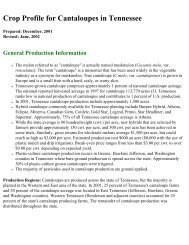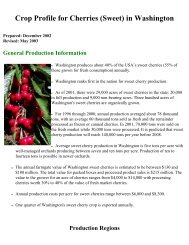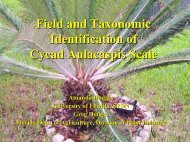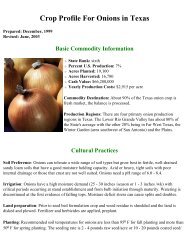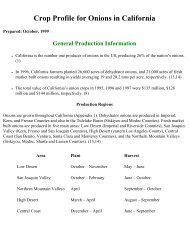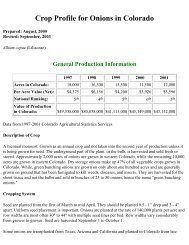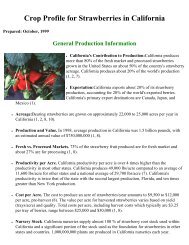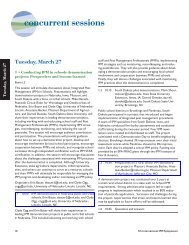Crop Profile for Onions in New York - Regional IPM Centers
Crop Profile for Onions in New York - Regional IPM Centers
Crop Profile for Onions in New York - Regional IPM Centers
You also want an ePaper? Increase the reach of your titles
YUMPU automatically turns print PDFs into web optimized ePapers that Google loves.
Use <strong>in</strong> Resistance Management: The onion maggot has displayed a marked ability to develop resistance to<br />
<strong>in</strong>secticides. Resistance to chlorpyrifos has been documented <strong>in</strong> a number of onion grow<strong>in</strong>g areas, and while it is still<br />
at relatively low levels, the problem is becom<strong>in</strong>g more widespread.<br />
Alternatives: The onion <strong>in</strong>dustry is <strong>in</strong> dire need of effective alternatives to chlorpyrifos, and until at least two are<br />
registered and available <strong>for</strong> use, producers must depend on chlorpyrifos <strong>for</strong> onion maggot control. While diaz<strong>in</strong>on is labeled<br />
<strong>for</strong> use, it does not provide commercially acceptable levels of control. Federal registration of cyromaz<strong>in</strong>e seed treatment<br />
would be a first step, but more options are needed. Cyromaz<strong>in</strong>e (an <strong>in</strong>sect growth regulator) can be very effective, but this<br />
is somewhat weather dependent. Cyromaz<strong>in</strong>e may also affect the germ<strong>in</strong>ation of seed carried over from the previous season,<br />
a common practice among producers. Fipronil (applied as a seed treatment at 0.04 lbs ai/acre) has been tested over<br />
several years <strong>in</strong> field trials and appears to be highly effective aga<strong>in</strong>st this pest. One experimental material<br />
(EXP80572B) showed promis<strong>in</strong>g results <strong>in</strong> 1998 trials. A new material, thiomethoxam (Adage) from Novartis, may also<br />
prove to be a useful alternative. Research is planned <strong>for</strong> 1999.<br />
Efficacy Issues: Efficacy of Lorsban is becom<strong>in</strong>g compromised because of resistance problems. Cyromaz<strong>in</strong>e can be<br />
very effective, except when weather is very dry. Foliar sprays are of questionable efficacy s<strong>in</strong>ce they must contact the<br />
adult, and flies migrate <strong>in</strong> and out of fields.<br />
Onion Thrips (Thrips tabaci)<br />
Frequency of Occurrence: Annually.<br />
Damage Caused: Thrips are often found between the leaf sheath and stem on onions where they are out of reach<br />
of <strong>in</strong>secticides and many natural control agents. Thrips primarily damage crops directly by their rasp<strong>in</strong>g and feed<strong>in</strong>g<br />
activities, caus<strong>in</strong>g whitish blotches on leaves. Severe damage to onions will cause leaves to senesce prematurely and bulbs<br />
to become distorted or rema<strong>in</strong> undersized. Hot, dry weather is correlated with occurrence of severe thrips problems.<br />
% Acres Affected: 100%<br />
Pest Life Cycles: Thrips are a very important annual pest of onions. Adults and nymphs overw<strong>in</strong>ter on plants or debris or<br />
along weedy field edges. The females can reproduce without mat<strong>in</strong>g and lay eggs beneath the leaf surface. Eggs hatch after<br />
5-10 days and nymphs are fully-grown after 15 to 30 days. Development of the last two nymphal stages occurs <strong>in</strong> the<br />
soil, without feed<strong>in</strong>g. After the 4th molt, adult female thrips return to the plant. There are usually 5-8 generations per year,<br />
and they have a relatively wide host range.<br />
Tim<strong>in</strong>g of Control: mid- to late summer<br />
Yield Losses: Up to 50% <strong>in</strong> severely affected fields.<br />
Cultural Control Practices: Heavy ra<strong>in</strong> or overhead irrigation can reduce thrips populations. Some older onion varieties<br />
with more open canopy growth tend to have fewer thrips.<br />
<strong>Regional</strong> Differences: None.<br />
Biological Control Practices: Onion thrips have several natural enemies. Their effectiveness can be improved by<br />
apply<strong>in</strong>g <strong>in</strong>secticides judiciously.<br />
Post-Harvest Control Practices: None.<br />
Other Issues: Research on thrips biology, control, and patterns of resistance is ongo<strong>in</strong>g (Eckenrode and Straub).<br />
Chemical Controls <strong>for</strong> Onion Thrips and Onion Maggot Adults:



